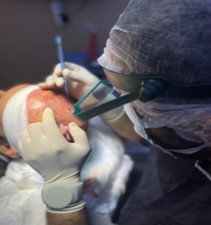
Even if the first hair transplant trials were conducted 200 years ago [1], the current hair transplantation technology has evolved in the last 30 years along with other medical advancements.
The techniques used in the 1950s are quite different from the ones we use today, thanks to dermatologists who have been pioneers in the field of hair restoration surgeries.
However, these advancements have brought a lot of questions. The most frequent one I have been answering is “What is the best hair transplant technology? And why?”
Without further ado, let’s look at the newest and latest technology and techniques in hair transplantation.
How did hair transplantation start?
Surprisingly the first hair transplant surgery trials date back to the 19th century. In 1822, the first bird feather and scalp to body hair transplant trials were conducted by Ph.D. student Dieffenbach in Germany.
Then in 1897, an Ottoman Dermatologist, Dr. Hodara, performed a hair transplant on a patient having a ringworm-related hair loss problem. After 3-4 months, some hairs grow in a newly transplanted area and become colored and strong [2].
Sapphire FUE
In the implantation stage of hair restoration surgery, the surgeon first makes incisions and then puts hair grafts inside this incision.
Typically, steel blades had been used before the sapphire blade innovation to make incisions. These incisions couldn’t get smaller after a point. With the arrival of expensive sapphire tips that are very sharp, smooth, and durable, smaller incisions have become possible.
Benefits of smaller and more precise micro incisions:
- Increased precision and more natural-looking results,
- Less trauma, swelling, pain, and bleeding,
- Faster recovery time,
- Increased likelihood of success.
In modern Sapphire FUE operations, 5000 grafts can be transplanted in 8-10 hours.

DHI
In 1999, a new tool called the DHI implanter pen was introduced by the DHI Medical Group [3].
With the new tool, incision and implantation become simultaneous replacing both sapphire and steel tips and forceps. The surgeon can put hair grafts into the recipient zone in just one step.
This allowed the surgeon to take full control of the graft’s angle, direction, and depth.
More and more patients are choosing DHI over FUE these days. However, there is one important weak side of the DHI technique. The maximum number of grafts transplanted in DHI is lower than FUE. Generally, in a session, a surgeon can implant a maximum of 3500 grafts in 8-10 hours.
Some hair restoration clinics assert that DHI is faster than FUE since incision and implantation are simultaneous, thanks to the implant pen. If they say so, it means they don’t have a surgeon and 2 technicians implanting grafts together. 2 different operators mean 2 different surgical styles and angles. This may result in hair transplant failures.
Advantages of DHI:
- Good for unshaved hair transplantation,
- Easy to protect existing hair while transplanting,
- Easy control of grafts angle, depth, and direction,
- Less bleeding and faster recovery.
Artas Robotic Hair Transplants
Humans do not perform the same all the time, but robots do. That’s where hair transplantation robots are very good at it; repeating the same implantation maneuver thousands of times without getting tired.
The Artas Hair Transplant Robot was introduced in 2007 and it was given FDA approval in 2011. It is the first commercially available hair restoration robot.
Contrary to common belief, the ARTAS hair transplantation robot can’t do graft implantation but helps with the graft transplant pattern and plan. Thanks to its advanced algorithm, it is very good at graft harvesting and causes minimal damage to the donor zone.
The drawbacks of robotic hair transplantation are:
- Lacking judgment,
- Not being able to handle extreme cases and complications
- High cost
- Need for strong assistance
Biologic Advancements – Bio-Enhanced Hair Restoration
The final, latest, and less known advancement in hair transplant surgery is bio-enhanced hair restoration.
It was first introduced in a 2014 publication of ISHRS and shown to significantly affect the final result of the operation [4].
Special intracellular biopreservation liquids are used in the heart, kidney, and other transplantations. However, in hair transplantation (hair can be considered an organ), these solutions are often overlooked, which causes precious donor grafts to be lost.
Basically, during the hair restoration process, hair cells wait 4 or 5 days before connecting to the blood supply again in the transplanted area.
In 4-5 days, 10-15% of hair grafts may die, even if the surgeon and clinic perfectly finish the operation.
Cells are not exposed to external pressure in bio-enhancements and get nutrients for recovery and growth.
In Turkey, just a few hair transplant clinics have been using them since these solutions significantly increase the cost.
We achieve excellent results thanks to this new advancement at UnitedCare.
What is the best hair transplant technology? And why?
Finally, we’re back to the initial question.
There is no best technique; each one has pros and cons.
For example, if you have lost the majority of your scalp hair and your donor capacity is low, infamous FUT might be better for you.
If you want an unshaven hair transplant and your hair loss is minimal/moderate, DHI might be better.
A dermatologist surgeon would recommend the best technique for you after an examination.
References
- Unger, Walter P. “The history of hair transplantation.” Dermatologic surgery 26.3 (2000): 181-189.
- Tekiner H, Karamanou M. The forgotten hair transplantation experiment (1897) of Dr. Menahem Hodara (1869 − 1926). Indian J Dermatol Venereol Leprol 2016;82:352-355
- https://dhiglobal.com/about/milestones/
- https://www.ishrs-htforum.org/content/htfi/24/4/121.full.pdf




Facebook Comments